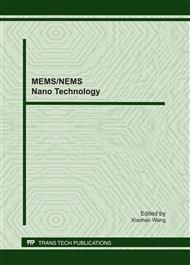p.43
p.48
p.53
p.58
p.62
p.66
p.70
p.75
p.78
Application of KOH Anisotropic Etching in the Fabrication of MEMS Devices
Abstract:
It is known that the wet chemical etching of silicon in alkaline solution has attracted wide attention due to its advantages such as lower cost, simpler setup, higher rate, smoother surface at micro level, higher degree of anisotropy, and lower pollution. In this paper, the key processes of fabricating vacuum microelectronic accelerometer and slits are presented. The cone curvature radius of the silicon tip arrays less than 30nm was fabricated with wet anisotropic etching of silicon in 33wt. % KOH solution at 70°C added potassium iodine (KI) and Iodine (I2) as additive and the cone aspect ratio was about 0.7. Smooth surface after etching in 33wt. %KOH solution added isopropyl alcohol (IPA) at 80°C was obtained and lateral etching was less than 5um after etching several hours for etching depth over 400um. Scalar slits with bottom width 25um and depth 500um were attained. A constant etch rate lead to precise and reproducible production. The test result reveals that the process to a specific occasion can reach practical requirements.
Info:
Periodical:
Pages:
62-65
Citation:
Online since:
June 2011
Authors:
Price:
Сopyright:
© 2011 Trans Tech Publications Ltd. All Rights Reserved
Share:
Citation:


